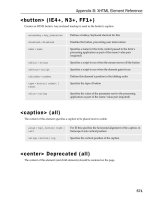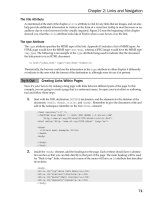Designing Next Generation Web Projects with CSS3 pptx
Bạn đang xem bản rút gọn của tài liệu. Xem và tải ngay bản đầy đủ của tài liệu tại đây (6.09 MB, 288 trang )
www.it-ebooks.info
Designing Next Generation
Web Projects with CSS3
A practical guide to the usage of CSS3 – a journey
through properties, tools, and techniques to better
understand CSS3
Sandro Paganotti
BIRMINGHAM - MUMBAI
www.it-ebooks.info
Designing Next Generation Web Projects with CSS3
Copyright © 2013 Packt Publishing
All rights reserved. No part of this book may be reproduced, stored in a retrieval
system, or transmitted in any form or by any means, without the prior written
permission of the publisher, except in the case of brief quotations embedded in
critical articles or reviews.
Every effort has been made in the preparation of this book to ensure the accuracy
of the information presented. However, the information contained in this book is
sold without warranty, either express or implied. Neither the author, nor Packt
Publishing, and its dealers and distributors will be held liable for any damages
caused or alleged to be caused directly or indirectly by this book.
Packt Publishing has endeavored to provide trademark information about all of the
companies and products mentioned in this book by the appropriate use of capitals.
However, Packt Publishing cannot guarantee the accuracy of this information.
First published: January 2013
Production Reference: 1140113
Published by Packt Publishing Ltd.
Livery Place
35 Livery Street
Birmingham B3 2PB, UK.
ISBN 978-1-84969-326-4
www.packtpub.com
Cover Image by Rakesh Shejwal ()
www.it-ebooks.info
Credits
Author
Sandro Paganotti
Reviewers
Berg Brandt
Angelos Evangelou
Andrew Wasson
Acquisition Editor
Usha Iyer
Lead Technical Editor
Ankita Shashi
Technical Editors
Manmeet Singh Vasir
Dominic Pereira
Copy Editors
Brandt D'Mello
Insiya Morbiwala
Aditya Nair
Laxmi Subramanian
Ruta Waghmare
Project Coordinator
Joel Goveya
Proofreaders
Denise Dresner
Kevin McGowan
Indexer
Monica Ajmera Mehta
Graphics
Aditi Gajjar
Production Coordinator
Nilesh R. Mohite
Cover Work
Nilesh R. Mohite
www.it-ebooks.info
About the Author
Sandro Paganotti is a web developer, a Google Developers Expert in HTML5,
a technical writer, and an HTML5/CSS3 teacher with a passion for Ruby and
cutting-edge frontend technologies. He enjoys nding clever and pragmatic solutions
to ambitious projects at Comparto Web, the company he co-founded in 2012.
He's also a funding member of WEBdeBs, a local community of web enthusiasts, and
a speaker at local and national conferences.
I would like to thank everyone who developed the amazing libraries
presented in this book, Lea Verou (also for this hint, "the rst thing
you can say about CSS3 is that it doesn't actually exist"), the teams
behind Sass and Compass, Faruk Ateş, Paul Irish, and everyone
who contributes to Modernizr, Richard Herrera for Flexie and Jason
Johnston for CSS3 PIE. Also thanks to Sara Baroni and Paolo Dusi
for their amazing infographic that I used in Chapter 4, Zooming
User Interface.
A big thanks to Davide, Fabio, and Mattia, my partners at
Comparto Web.
Another big thanks to my editors at Packt Publishing for their time,
patience, and wise advice and to Alessandro Cinelli "cirpo" for his
useful review.
A special thanks to Andrea, my father, who shot all the photos used
in the projects of this book.
And last, a huge thanks to Francesca for the time she spent reading
my drafts, trying the projects for the book, and giving me support
during my long writing Sundays.
www.it-ebooks.info
About the Reviewers
Berg Brandt is a well-rounded frontend engineer/web developer and a web
designer with more than 12 years of experience in the Internet industry, specializing
in designing, developing, and maintaining websites and web applications for
different scales, markets, languages, and cultures.
Nowadays, Berg is the Engineering Team Leader of one of the Common User
Experiences track of the Yahoo! Publishing Platform (YPP). The YPP empowers more
than 300 high-trafc websites that reach millions of users across the globe every day.
Berg is one of the project founders and the main author of the YPP CSS framework,
one of its key components.
Angelos Evangelou is a web designer focused on creating templates. He obtained
a degree in Web and Multimedia and has good knowledge of open source CMS
platforms. He mainly loves to code and design websites from scratch, and as such,
now focuses much of his time on template production.
I would like to thank my parents and brothers. They have helped me
have the condence to pursue what I enjoy.
www.it-ebooks.info
Andrew Wasson is a partner at Luna Design, a graphic design and web
development studio in North Vancouver, British Columbia, Canada. Keenly
interested in electronics and technology, Andrew built his rst computer in high
school and thus began his journey in computer programming, starting with machine
language assemblers and then graduating to variations of Basic and C. Andrew has
been developing and producing websites since 1998 and is active within the online
community helping others master the ner points of website development. When
he is not sharing the responsibilities of running their business with his wife Fiona,
Andrew can be found riding or restoring his vintage ex-racing motorcycles.
www.it-ebooks.info
www.PacktPub.com
Support les, eBooks, discount offers
and more
You might want to visit www.PacktPub.com for support les and downloads related to
your book.
Did you know that Packt offers eBook versions of every book published, with PDF and ePub
les available? You can upgrade to the eBook version at www.PacktPub.com and as a print
book customer, you are entitled to a discount on the eBook copy. Get in touch with us at
for more details.
At www.PacktPub.com, you can also read a collection of free technical articles, sign up for a
range of free newsletters and receive exclusive discounts and offers on Packt books and eBooks.
TM
Do you need instant solutions to your IT questions? PacktLib is Packt's online digital book
library. Here, you can access, read and search across Packt's entire library of books.
Why Subscribe?
• Fully searchable across every book published by Packt
• Copy and paste, print and bookmark content
• On demand and accessible via web browser
Free Access for Packt account holders
If you have an account with Packt at www.PacktPub.com, you can use this to access PacktLib
today and view nine entirely free books. Simply use your login credentials for immediate access.
www.it-ebooks.info
www.it-ebooks.info
To Francesca, my parents, and Comparto Web.
www.it-ebooks.info
www.it-ebooks.info
Table of Contents
Preface 1
Chapter 1: No Sign Up? No Party! 7
HTML structure 8
Reset stylesheet and custom fonts 9
Creating the form 10
Misplaced labels 11
Basic styling 13
Dening properties 15
Marking required elds 18
The checked radio buttons trick 20
Displaying icons within radio button labels 21
Counting and displaying invalid elds 24
Implementing the counters 25
Balloon styling 26
Graceful degradation 28
Summary 30
Chapter 2: Shiny Buttons 31
Creating a coin-operated push button 32
The :before and :after pseudo-selectors 33
Gradients 35
The gradient syntax 36
Avoiding experimental prexes 38
Upcoming syntax changes for CSS3 gradients 40
Shadows 41
Adding labels 43
Handling mouse clicks 44
Small changes in CSS, big results 46
www.it-ebooks.info
Table of Contents
[ ii ]
Creating an ON/OFF switch 47
Creating a mask 48
The active state 51
Adding the checked state 52
Adding colors 52
Supporting older browsers 53
Supporting IE10 56
Summary 56
Chapter 3: Omni Menu 57
Setup operations 58
Styling the rst-level items 61
Using the inline-block display 62
Using new pseudo-selectors 63
Completing the rst level 64
Styling submenus 64
Moving parts 66
Adding transitions 68
Introducing animations 71
Adding colors 74
Media queries 76
Styling the mobile version 80
Handling the new layout on desktop browsers 84
Final adjustments 86
Improving speed 87
Implementing in older browsers 88
Summary 88
Chapter 4: Zooming User Interface 89
Infographics 90
Implementing Flexible Box Layout 92
Dening the basic structure 95
Adding Polylls 96
Embedding SVG 99
Taking advantage of Modernizr 102
The :target pseudo-selector 105
Adding some anchors 108
CSS3 transforms 109
Applying transformations 112
Flashing issues 113
Adding a mask 114
Targeting SVG with CSS 117
www.it-ebooks.info
Table of Contents
[ iii ]
Graceful degradation 119
Summary 122
Chapter 5: An Image Gallery 123
Preparing the structure 123
Applying the basic CSS 125
Styling the bullets 128
Implementing opacity transition 129
Implementing slide transition 130
3D transformations 132
Adding the slideshow mode 135
Previous and next arrows 138
CSS preprocessors 140
Handling special cases 142
Support for older browsers 144
Summary 145
Chapter 6: Parallax Scrolling 147
Discovering perspective 148
Creating a cube 150
The perspective-origin property 153
CSS 3D parallax 154
Implementing parallax scrolling in WebKit 156
Implementing parallax scrolling in Gecko 158
Implementing parallax scrolling in Internet Explorer 160
Adding some randomness to the gallery 162
Rotating the images 165
A 3D panorama 166
Dealing with older browsers 168
Summary 169
Chapter 7: Video Killed the Radio Star 171
The HTML5 video element 171
Masks 173
More advanced masking 175
Implementing the project 179
Animating masks 182
WebKit-specic properties 183
Masking with text 185
Filters 187
Grayscale lter 189
Summary 190
www.it-ebooks.info
Table of Contents
[ iv ]
Chapter 8: Go Go Gauges 191
A basic gauge structure 191
Installing Compass 192
CSS reset and vendor prexes 194
Using rem 195
Basic structure of a gauge 197
Gauge tick marks 198
Dealing with background size and position 200
Creating the arrow 203
Moving the arrow 204
Animating the gauge 206
Overall indicator 206
Reducing the size of the CSS 208
Adding some trembling 208
Displaying the gauge value 210
Graceful degradation 211
Implementing the gauge in Internet Explorer 8 213
Compass and Internet Explorer 10 217
Summary 219
Chapter 9: Creating an Intro 221
Project description 221
Creating an HTML structure 222
Creating the slide 224
The new Flexible Box Model 225
Creating a sample layout 228
Disposing the slides 231
Moving the camera 232
Fun with animations 235
Step animations 237
Final touches 239
Summary 240
Chapter 10: CSS Charting 241
Creating a bar chart 241
Subdividing the space 243
Adding Internet Explorer 8 and 9 support 245
Creating bar labels 246
Designing the bars 247
Beautifying the chart 249
Chart lines 251
www.it-ebooks.info
Table of Contents
[ v ]
Chart series 253
Adding some animations 256
Internet Explorer 8 and 9 256
Rotating the chart 257
Creating pie charts using only CSS and HTML 259
Summary 260
Index 261
www.it-ebooks.info
www.it-ebooks.info
Preface
You'll be surprised, but CSS3 doesn't exist. Actually, this term is used to
group a wide number of different specications (see the the list at
each of them with its own
working team and completion state. Some are still Working Drafts while others
are already Candidate Recommendations.
This book tries to present you with a snapshot of what can be done today with this
technology. It is organized into 10 projects, each of them relying heavily on some
of the new CSS features such as background gradients, Flexible Box Layout, or
CSS lters.
All the projects have been developed and tested to work on the latest Chrome and
Firefox browsers. The vast majority of them render and behave well even on Internet
Explorer 10.
Wherever possible, a workaround to make things work even on older browsers is
provided. In this way, different techniques and tools are introduced, such as feature
detection with Modernizr, graceful degradation, fallback properties triggered with
conditional comments, and a bunch of quality polyll libraries.
The book also focuses on different kinds of tools, that are aimed at helping us while
developing rather complex CSS documents. I'm talking about Sass and Compass,
which provide us with a new syntax to better organize our project, and a bunch of
useful functions that we'll see later in this book.
Dealing with vendor experimental prexes is annoying. In this book, we'll discover
how to use some libraries that do this task for us, either client or server side.
Well, there's nothing more to say here, I hope that you'll nd the projects at least
as interesting and fun to develop as I did, and that from them you'll learn new
techniques, properties, and tools to help in your day-to-day job.
www.it-ebooks.info
Preface
[ 2 ]
What this book covers
Chapter 1, No Sign Up? No Party!, will show you how to create a subscription form
for your upcoming party. We use this chapter to discover how CSS3 features, such as
some new pseudo-selectors, can enhance a form by adding specic styles to required
elds or to valid/invalid ones.
Chapter 2, Shiny Buttons, will show you how to create some CSS3 enhanced buttons
by using techniques such as rounded corners, multiple backgrounds, gradients,
and shadows. Then we animate them using the classic
:hover pseudo-selector with
CSS3 transitions.
Chapter 3, Omni Menu, focuses on developing a menu that behaves differently
according to the device we are using to view it. We achieve this goal using media
queries and a nice feature detection library.
Chapter 4, Zooming User Interface, uses CSS3 transitions mixed with SVG graphics and
the new
:target pseudo-selector to create a fully functional zooming user interface
that displays a cool infographic.
Chapter 5, An Image Gallery, will show you how to develop a pure CSS3 image
slideshow with different transition effects such as fading, sliding and 3D rotation, and
multiple navigation modes. Switching between different effects is made possible using
the new
:checked pseudo-selector. This chapter also introduces Sass, an extension of
CSS3 that we can use to write cleaner, more readable, and smaller CSS les.
Chapter 6, Parallax Scrolling, focuses on building a real parallax effect triggered
on page scroll. This is archived using 3D transform properties, such as
transform-style and perspective.
Chapter 7, Video Killed the Radio Star, experiments with some cool video effects that
can be archived using CSS3, including static and animated masks, blur, black and
white, and so on. This chapter also deals with some interesting backward- and
cross-browser compatibility issues.
Chapter 8, Go Go Gauges, shows how to take full advantage of the new CSS3
properties by creating an animated gauge that can be used as a widget in a
webpage. This project also introduces the Compass: a Sass plugin that takes care of
experimental prexes, Reset stylesheet, and so on.
Chapter 9, Creating an Intro, takes CSS3 animations to another level by creating a 3D
animation that uses a camera moving in a 3D scene.
Chapter 10, CSS Charting, will show you how to create bar charts and pie charts
with CSS3 without the need for anything other than CSS and HTML. With the right
polylls we can then make these charts behave well even on older browsers.
www.it-ebooks.info
Preface
[ 3 ]
What you need for this book
To develop the projects provided with this book you need a text editor (for example,
Sublime Text 2, Notepad ++, and so on), and a web server to run the code. If you
have never installed a web server, you may want to use a pre-packaged solution
such as MAMP for Mac (
o/en/mamp/index.html) or
WampServer for Windows (
These packages also
install PHP and MySQL, that are not required to run the projects of this book, so you
can simply ignore them.
Once you have downloaded, installed, and started the web server, you can create the
projects within the web server's document root.
Who this book is for
This book is designed for frontend web developers. It requires a solid knowledge of
CSS syntax and of the most common CSS2 properties and selectors.
Conventions
In this book, you will nd a number of styles of text that distinguish between
different kinds of information. Here are some examples of these styles, and an
explanation of their meaning.
Code words in text are shown as follows: "We used the
:after pseudo-selector to
get access to the location just after the element with a label class."
A block of code is set as follows:
html{
height: 100%;
background: black;
background-image: url(' /img/background.jpg');
background-repeat: no-repeat;
background-size: cover;
background-position: top left;
font-family: sans-serif;
color: #051a00;
}
www.it-ebooks.info
Preface
[ 4 ]
When we wish to draw your attention to a particular part of a code block, the
relevant lines or items are set in bold:
#old_panel{
background: rgb(150,130,90);
padding: 9px 0px 20px 0px;
}
Any command-line input or output is written as follows:
sass scss/application.scss:css/application.css
New terms and important words are shown in bold. Words that you see on the
screen, in menus or dialog boxes for example, appear in the text like this: "Let's mark
border-radius, box-shadow, CSS Gradients, and multiple backgrounds."
Warnings or important notes appear in
a box like this.
Tips and tricks appear like this.
Reader feedback
Feedback from our readers is always welcome. Let us know what you think about
this book—what you liked or may have disliked. Reader feedback is important for us
to develop titles that you really get the most out of.
To send us general feedback, simply send an e-mail to
,
and mention the book title via the subject of your message.
If there is a topic that you have expertise in and you are interested in either writing
or contributing to a book, see our author guide on
www.packtpub.com/authors.
Customer support
Now that you are the proud owner of a Packt book, we have a number of things to
help you to get the most from your purchase.
www.it-ebooks.info
Preface
[ 5 ]
Downloading the example code
You can download the example code les for all Packt books you have purchased
from your account at . If you purchased this book
elsewhere, you can visit and register to
have the les e-mailed directly to you.
Errata
Although we have taken every care to ensure the accuracy of our content, mistakes
do happen. If you nd a mistake in one of our books—maybe a mistake in the text or
the code—we would be grateful if you would report this to us. By doing so, you can
save other readers from frustration and help us improve subsequent versions of this
book. If you nd any errata, please report them by visiting ktpub.
com/support
, selecting your book, clicking on the errata submission form link, and
entering the details of your errata. Once your errata are veried, your submission
will be accepted and the errata will be uploaded on our website, or added to any list
of existing errata, under the Errata section of that title. Any existing errata can be
viewed by selecting your title from />Piracy
Piracy of copyright material on the Internet is an ongoing problem across all media.
At Packt, we take the protection of our copyright and licenses very seriously. If you
come across any illegal copies of our works, in any form, on the Internet, please
provide us with the location address or website name immediately so that we can
pursue a remedy.
Please contact us at
with a link to the suspected
pirated material.
We appreciate your help in protecting our authors, and our ability to bring you
valuable content.
Questions
You can contact us at if you are having a problem with
any aspect of the book, and we will do our best to address it.
www.it-ebooks.info
www.it-ebooks.info
No Sign Up? No Party!
CSS3 has been a big leap forward for forms. Not only are new style possibilities
available, but new and powerful pseudo-selectors can also now be used to modify
the appearance of our page, depending on the state of the form or of its elds.
In this chapter, we will use a party registration form as a test case to show how
this component can be enhanced by the new CSS specications. We will also pay
attention to how we can retain the right behavior for older browsers. We're going
to cover the following topics:
• HTML structure
• The form
• Basic styling
• Marking required elds
• The checked radio buttons trick
• Counting invalid elds
• Balloon styling
www.it-ebooks.info
No Sign Up? No Party!
[ 8 ]
HTML structure
Let's start with some HTML5 code to shape the structure of our project's
web page. To do so, create a le, named index.html, in a new folder, named
no_signup_no_party, containing the following markup:
<!doctype html>
<html>
<head>
<meta charset="utf-8">
<meta http-equiv="X-UA-Compatible" content="IE=edge"/>
<title>No signup? No party!</title>
<link rel="stylesheet" type="text/css"
href=" />min.css">
<link rel='stylesheet' type='text/css'
href=' /> <link rel='stylesheet' type='text/css'
href='css/application.css'>
<script
src=" /></script>
</head>
<body>
<article>
<header>
<h1>No signup? No party!</h1>
<p>
Would you like to join the most amazing party of the
planet? Fill out this form with your info but hurry up! only a
few tickets are still available!
</p>
</header>
<form name="subscription">
<! FORM FIELDS >
<input type="submit" value="Yep! Count me in!">
</form>
<footer>
Party will be held at Nottingham Arena next sunday, for info
call 555-192-132 or drop us a line at
</footer>
</article>
</body>
</html>
www.it-ebooks.info









